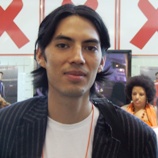Brun González: "The intention is to open people's eyes, not give orders"

The civil association Espoli, Mexico, is an example of an institution that works with the concept of peer action, seeking to empower youth to participate in projects and initiatives that generate knowledge and information, and that from the perspective of youth, enable us to act as agents of change and to promote respect for the human rights.
One of the young people, who are working in Espoli, is Brun González. With his low voice and quiet talks, he combines his juvenile disposition of his 22 years of age, with a mature attitude of a veteran. Invited to attend the VIII Brazilian Congress of Prevention of STD and AIDS, in Brasilia, he spoke to UNODC on his experience. Check the main points of the interview.
Is there a gap between public policy and the reality of drug users?
Many of the studies that the government and the government agencies make are very superficial, because in practice, the people that have the most problems do not give their opinion or do not share their experiences, fearing they'll be framed as consumers, or that they'll be pursued or that they'll be arrested. Often, only a part of reality is shown in the statistics, but it rarely reflects reality as a whole.
How can the state and civic associations act in a complementing form?
The civil society organizations can use public health sector resources as a sort of sponsorship, so that they'll be implementing the policies of harm reduction. For example, the health sector can pay for syringes, alcohol, cotton and chlorine. For them, that does not cost much, because they have to provide medical supplies to hospitals. Moreover, this is part of their responsibility as a government. On the other hand, the civil organizations can offer their time and effort, building networks channels of distribution of syringes and information. These organizations benefit from education tools, so that they - and not the state - can generate greater confidence. This must occur incrementally. The state, for example, can print leaflets, but distribution can be done by civil society organizations, which are responsible for the construction of a horizontal relationship with the users and the families of these users. They are the ones working directly in the communities.
What is the best way to approach that will have an effective impact among drug users?
The intention is to open people's eyes, not to give orders or instructions about how things should be. You provide information so people can weigh their decisions in an objective manner, offering the most comprehensive scenario possible. This occurs when reflecting with the users the impacts that they see (but often ignored) in relation to their families and friends as well as in their bodies, which they do not realize, because of the drugs and the psychological impact. The goal is to try to raise awareness of the real problem in all dimensions and offer pathways that when people take any decisions, either for detoxification with the substitution of methadone, or to change the levels of consumption or intensity of the substance, they have all the support and access to the tools available.
The substitution of substances is the best way to reduce the damage?
The replacement does not need to be just an opiate like heroin to another control, such as methadone. These are the medical terms for replacement. But in reality, the replacement has to do with changes from one type of consumer to the other, where there is less of an impact on the body, or a lower impact on the mental productivity of certain people. This means that the person who chooses to use these substances have access, knowledge and the notion that there are substances that dissolve your liver in two years and others that can be used for 50 years without a lot of problem.
What is the best way to achieve effective results in protecting the health of drug users?
An entity, a person or a group of people who can not do everything that needs to be done, all is needed. We must build a network of different organizations, of different people doing different things, but in a coordinated manner, embracing as many problems as possible, in all the possible different angles.